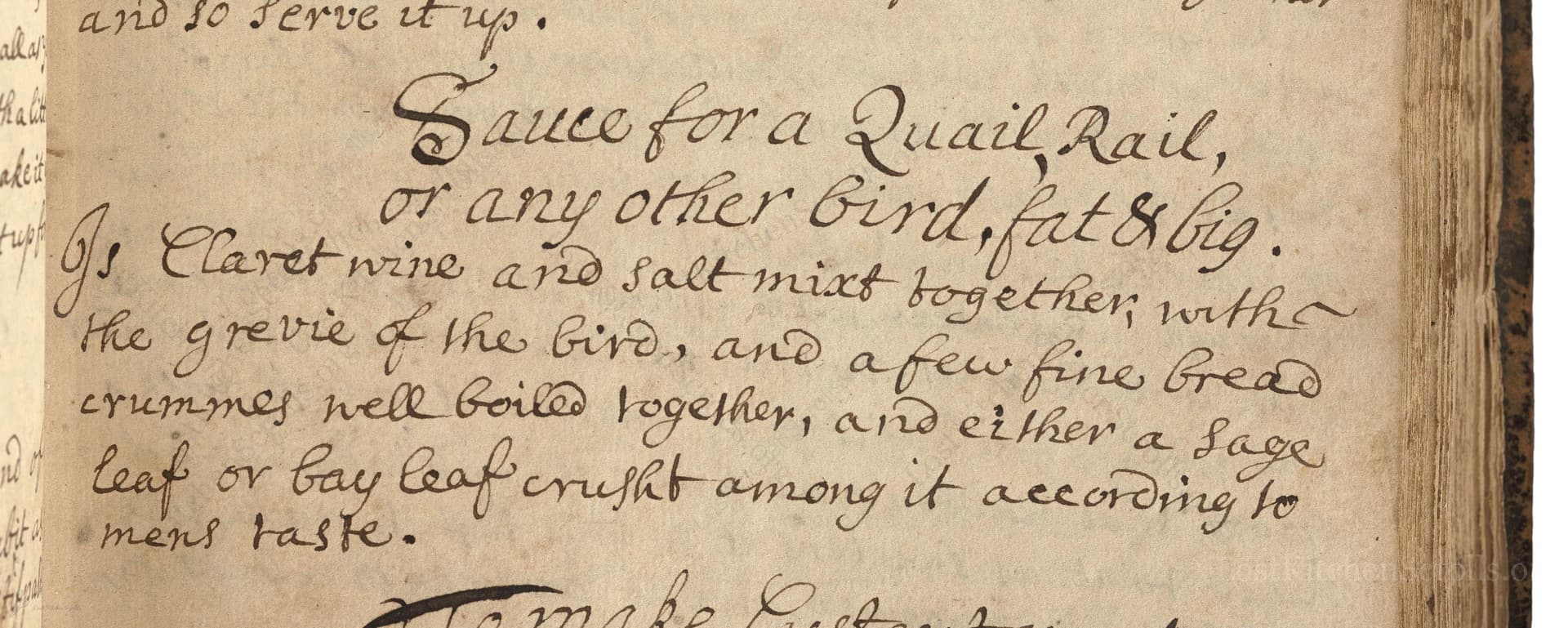
Sauce For A Quail, Rail, Or Any Other Bird, Fat & Big
"Is Claret wine and salt mixt together, with the grevie of the bird, and a few fine bread crummes well boiled together, and either a Sage leaf or bay leaf crusht among it according to mens taste."
Note on the Original Text
The recipe reflects the early 18th-century English style of sparse instruction, minimal measures, and direct reference to available kitchen resources (like pan juices). Spellings such as 'grevie' (for gravy) and 'mens taste' (for 'to taste') are typical of the era. Recipes assume familiarity with basic kitchen work and flexibility in herbs. The inclusion of a single sage or bay leaf 'crusht among it' shows an approach of 'season as you like' which was common for the time.

Title
Cookbook (1706)
You can also click the book image above to peruse the original tome
Writer
Unknown
Era
1706
Publisher
Unknown
Background
Step back to the early 18th century with this charming culinary collection, brimming with period recipes that tantalize the tastebuds and offer a delicious glimpse into historic kitchens.
Kindly made available by
Folger Shakespeare Library
This recipe comes from early 18th-century England, circa 1706, a time when sauces were often simple and crafted to enhance the natural flavors of roasted meats and game. Claret, a popular imported French wine, was prized for both drinking and cooking. Birds like quail or rail, enjoyed by the gentry, provided a rich, flavorful base for gravies and sauces. This particular sauce illustrates the economical use of pan drippings and the subtle use of herbs popular in the period.

Cooks would have prepared this sauce in a small metal saucepan or pipkin over an open hearth or range fire. A sturdy spoon or wooden spatula would be used to stir and blend the ingredients, and herbs would be bruised or crushed by hand or with a mortar and pestle. Bread would have been grated to make crumbs, often using a simple grater or by rubbing stale bread against a coarse screen.
Prep Time
5 mins
Cook Time
7 mins
Servings
2
We've done our best to adapt this historical recipe for modern kitchens, but some details may still need refinement. We warmly welcome feedback from fellow cooks and culinary historians — your insights support the entire community!
Ingredients
- 3.5 fl oz dry red wine (Claret; modern substitute: Cabernet Sauvignon or Bordeaux-style wine)
- 1/2 tsp sea salt
- Pan juices from one roasted large bird (quail, rail, or a similarly fatty fowl)
- 1/2 oz fine white breadcrumbs
- 1 sage leaf or 1 bay leaf (fresh)
Instructions
- To make this classic sauce, start by roasting a large, fatty bird such as quail or rail and reserve its pan juices (gravy).
- In a small saucepan over low heat, combine about 3.5 fl oz of dry red wine (Claret) with a generous pinch (about 1/2 tsp) of sea salt and the reserved gravy or juices from the roasted bird.
- Add approximately 1/2 oz of fine white breadcrumbs to the mixture.
- Stir continuously and simmer gently for 5–7 minutes until the sauce thickens nicely.
- For a herbal note, crush a single fresh sage leaf or bay leaf in your hand, then add it to the sauce according to your taste.
- Remove the herb before serving.
- Serve warm with your roasted bird.
Estimated Calories
60 per serving
Cooking Estimates
It takes about 5 minutes to gather and prepare the ingredients, and 7 minutes to cook the sauce. Each serving has about 60 calories. This recipe makes enough sauce for 2 servings.
As noted above, we have made our best effort to translate and adapt this historical recipe for modern kitchens, taking into account ingredients nowadays, cooking techniques, measurements, and so on. However, historical recipes often contain assumptions that require interpretation.
We'd love for anyone to help improve these adaptations. Community contributions are highly welcome. If you have suggestions, corrections, or cooking tips based on your experience with this recipe, please share them below.
Join the Discussion
Rate This Recipe

Den Bockfisch In Einer Fleisch Suppen Zu Kochen
This recipe hails from a German manuscript cookbook compiled in 1696, a time whe...

Die Grieß Nudlen Zumachen
This recipe comes from a rather mysterious manuscript cookbook, penned anonymous...

Ein Boudain
This recipe comes from an anonymous German-language manuscript cookbook from 169...

Ein Gesaltzen Citroni
This recipe, dating from 1696, comes from an extensive anonymous German cookbook...
Browse our complete collection of time-honored recipes



